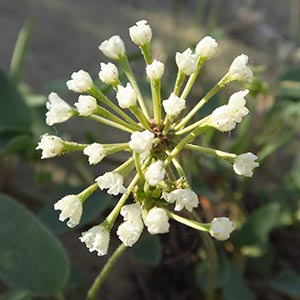Abronia mellifera
honey scented sand-verbena, white sand-verbena
decumbent to ascending, much branched, elongate, glabrous or glandular-pubescent.
petiole 1–6 cm;
blade ovate to lance-elliptic, 1–6 × 0.5–4 cm, margins entire to sinuate and ± undulate, surfaces glabrous or glandular-pubescent.
peduncle longer than subtending petiole;
bracts lanceolate to obovate, 5–12 × 1–5 mm, papery, glabrate to glandular-pubescent;
flowers 25–60.
tube pale rose proximally to greenish distally, 15–25 mm, limb white, 7–12 mm diam.
winged, broadly obdeltate or cordate in profile, 6–10 × 4–10 mm, thin, usually coriaceous, rarely indurate, base attenuate, apex prominently beaked;
wings (2–)5 (when 2, folded to form single deep groove), without dilations, broad, thin, without cavities.


